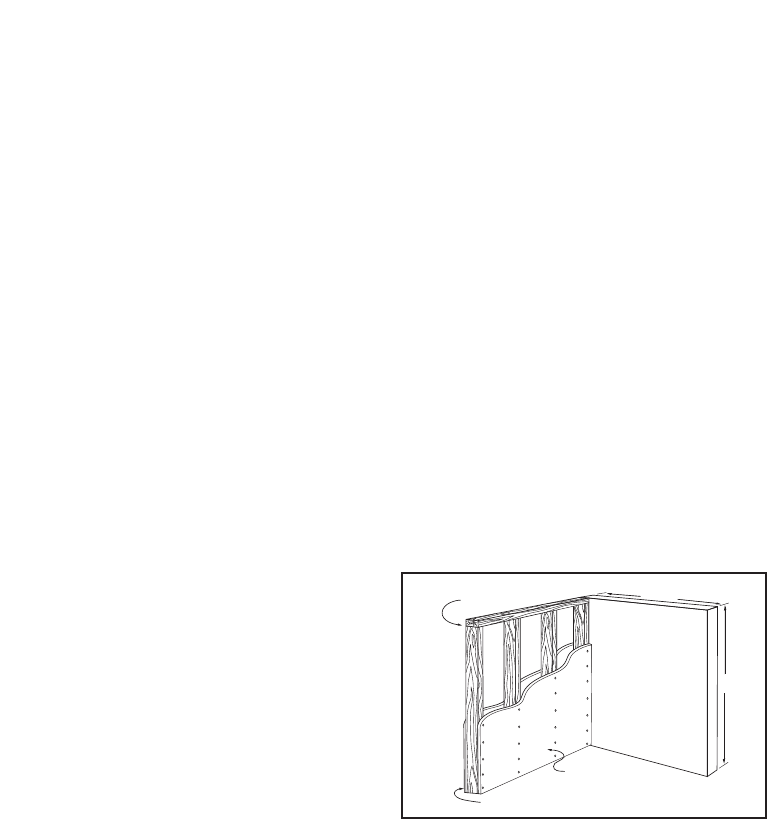
top surface of the low frequency cabinet. Be sure to observe
proper polarity. (See Figure 2.) Align the recesses on the bot-
tom surface of the high frequency cabinet with the rubber
bumpers on the top of the low frequency cabinet.
PLACEMENT
Your Klipsch Heritage loudspeakers will perform well in a vari-
ety of locations but best results will be achieved using the fol-
lowing general guidelines:
• Place on a common wall 6 to 15 feet apart.
• Position them equidistant from the back wall.
• Heresy: Equidistant height above the floor with the high
frequency drivers at seated ear height if wall or cabinet
mounted.
• Angle speakers toward the listener and even with or
forward of any adjacent obstructions.
• Placing them near a corner or wall provides the greatest
amount of bass while moving the speakers away from
room boundaries reduces bass energy.
• Asymmetrical placement of a pair of speakers from
adjacent side walls can smooth room-induced bass
unevenness.
• Experiment with the above guidelines to suit your taste and
to compensate for your room's acoustic characteristics.
Klipschorn
Klipschorn speakers typically perform best when positioned in
the corners on the long wall of a rectangular room. If the room
is very narrow and long with corners farther apart than 18 to
20 feet, the stereo image may not be optimal. A room with a
length to width ratio of 1.00 to .618 is preferred. In addition,
Klipschorn loudspeakers seem to benefit from ceiling heights
no lower than 8.5 feet.
The Klipschorn requires corner placement because the walls
of the room serve to complete the speaker’s low frequency
horn. To achieve full low frequency extension, the Klipschorn
should fit tightly in a corner without baseboard or trim interfer-
ence and the wall surfaces should extend at least 25 inches
beyond the side grilles. If proper corners are not available in
your listening room, false corners can be constructed to yield
bass performance similar to a full corner and also allow for
some adjustment of toe-in if desired. Start with a 2’ x 4’
framework as shown in Figure 3. Klipsch recommends using
standard 4 foot wide sheets of 3/4” plywood securely glued
and nailed to the framework. The backside may be covered
with a thinner material such as 3/16” masonite or 1/2” ply-
wood. Paint to match wall color, or finish with a laminate or
other material. (See Figure 3.) In the case of very wide spac-
ing, a false corner can be employed on one of the Klipschorns
to reduce the distance between speakers. Another solution to
widely spaced Klipschorn loudspeakers in an audio only sys-
tem is the addition of a center speaker such as the La Scala
to create a three-speaker stereo array. Please contact Klipsch
Technical Support at 1-800-554-7724 for connection details.
La Scala II
The La Scala II features a self-contained, front-firing, folded
bass horn to permit placement out of the corner if required.
However, because this model has less bass extension than the
Klipschorn, the low-frequency acoustic reinforcement of corner
placement may be optimal. The La Scala also offers full flexi-
bility with regard to the amount of toe-in achievable for the
desired stereo image. Deep bass performance may also be
augmented with a high performance Klipsch subwoofer.
Cornwall III
The Cornwall III offers the placement and toe-in flexibility of
the La Scala with low frequency extension similar to the
Klipschorn at a reduced output capability. As with the La Scala
and Heresy, corner positioning yields the greatest amount of
bass output while placements out of the corner or away from
rear walls will yield less bass. Since room acoustics and
personal taste vary we recommend experimenting with several
locations to fine tune the speaker’s performance. Self-stick
rubber pads are supplied for attachment to the bottom of the
riser for use on hard floors.
Heresy III
The Heresy III offers the greatest degree of placement flexibili-
ty of all of the Heritage models due to its relatively compact
size. It delivers the same basic frequency range as the La
Scala but at more modest output levels. Corner, floor place-
ment will deliver the highest degree of low bass reinforcement
and the slant riser base helps to compensate for the Heresy’s
short stature. This riser may be removed for shelf or cabinet
placement. Self-stick rubber pads are supplied for attachment
to the bottom of the cabinet to prevent scratching of shelves
and hard surfaces.
CONNECTING YOUR LOUDSPEAKER
Caution: Turn your amplifier off before making any
connections!
• Your loudspeakers are equipped with positive (Red) and
negative (Black) connection terminals, on the rear or side
of the cabinet. These correspond to the positive and
negative terminals on the appropriate channel (left, right,
center, rear, etc.) of your amplifier.
• All speakers in your system must be connected in phase
with the positive speaker terminal connected to the positive
amplifier terminal. Repeat this for the negative
speaker and amplifier terminals. Most speaker wire has
distinguishing markings on the insulation of one of the
conductors to assist in correct hookup.
• Use 16-gauge (AWG), two conductor, copper wire at a
minimum and larger gauge wire for longer runs. The
connection terminals on your loudspeaker will accommo
date bare wire, spade terminals or banana type plugs.
2" x 4" FRAME
122cm
approx. 48"
1
/2" PLYWOOD
3
/4"
PLYWOOD
98-132cm
39"-52"+
3


















